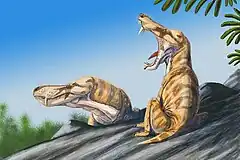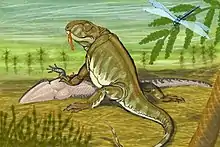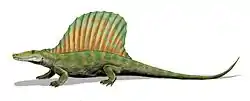| Sphenacodonts Temporal range: Late Pennsylvanian-Recent, | |
|---|---|
 | |
| 3D restoration of Dimetrodon grandis, a sphenacodontid | |
 | |
| Restoration of a pair of Alopecognathus angusticeps, a therocephalian therapsid | |
| Scientific classification | |
| Domain: | Eukaryota |
| Kingdom: | Animalia |
| Phylum: | Chordata |
| Clade: | Synapsida |
| Clade: | Sphenacomorpha |
| Clade: | Sphenacodontia Romer & Price, 1940 |
| Subgroups | |
Sphenacodontia is a stem-based clade of derived synapsids. It was defined by Amson and Laurin (2011) as "the largest clade that includes Haptodus baylei, Haptodus garnettensis and Sphenacodon ferox, but not Edaphosaurus pogonias".[4] They first appear during the Late Pennsylvanian (Upper Carboniferous) epoch. From the end of the Carboniferous to the end of the Permian, most of them remained large, with only some secondarily becoming small in size.
Basal Sphenacodontia constitute a transitional evolutionary series from early pelycosaurs to ancestral therapsids (which in turn were the ancestors of more advanced forms and finally the mammals). One might say that the sphenacodontians are proto-therapsids (even though there is almost a 30-million-years gap between the separation of the ancestors of therapsids from other sphenacodontians and the first appearance of therapsids in the fossil record).
Characteristics
The defining characteristics include a thickening of the maxilla visible on its internal surface, above the large front (caniniform) teeth; and the premaxillary teeth being set in deep sockets. All other (sister group and more primitive) synapsid clades have teeth that are set in shallow sockets.
Classification


The following taxonomy follows Fröbisch et al. (2011), Benson (2012) and Spinder (2016) unless otherwise noted.[3][4][5]
Class Synapsida
- Eupelycosauria
- Sphenacodontia
Phylogeny
Sphenacodontia in a cladogram after Fröbisch et al., 2011:[5]
| ||||||||||||||||||||||||||||||||||||||||||||||||||||||||||
See also
References
- 1 2 Spindler, Frederik (15 August 2019). "Re-evaluation of an early sphenacodontian synapsid from the Lower Permian of England" (PDF). Earth and Environmental Science Transactions of the Royal Society of Edinburgh. 111: 27–37. doi:10.1017/S175569101900015X. S2CID 202192911. Retrieved 8 October 2019.
- 1 2 Spindler, F.; Scott, Diane; Reisz, Robert (October 2014). "New information on the cranial and postcranial anatomy of the early synapsid Ianthodon schultzei (Sphenacomorpha: Sphenacodontia), and its evolutionary significance". Fossil Record. 18: 17–30.
- 1 2 Spindler, F. 2016. Morphological description and taxonomic status of Palaeohatteria and Pantelosaurus (Synapsida: Sphenacodontia). Freiberger Forschungshefte C550(23): 1–57. https://www.researchgate.net/publication/321129043_Morphological_description_and_taxonomic_status_of_Palaeohatteria_and_Pantelosaurus_Synapsida_Sphenacodontia
- 1 2 Benson, R.J. (2012). "Interrelationships of basal synapsids: cranial and postcranial morphological partitions suggest different topologies". Journal of Systematic Palaeontology. 10 (4): 601–624. doi:10.1080/14772019.2011.631042. S2CID 84706899.
- 1 2 Jörg Fröbisch; Rainer R. Schoch; Johannes Müller; Thomas Schindler; Dieter Schweiss (2011). "A new basal sphenacodontid synapsid from the Late Carboniferous of the Saar-Nahe Basin, Germany" (PDF). Acta Palaeontologica Polonica. 56 (1): 113–120. doi:10.4202/app.2010.0039.
- ↑ Spindler, Frederik (2020). "The skull of Tetraceratops insignis (Synapsida, Sphenacodontia)". Palaeovertebrata. 43 (1): e1. doi:10.18563/pv.43.1.e1. S2CID 214247325.




.jpg.webp)